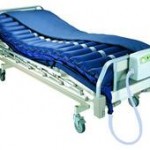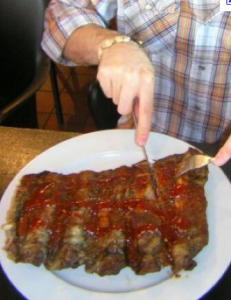Roy Shaw, EMT-Paramedic and Instructor Trainer for ProTrainings.com has embarked on a quest to cover all of the important updates and topics related to the new 2010 ECC/ILCOR and American Heart Association updates which are in the process of being released and communicated via email, news, TV, blogs, twitter, Facebook and any other means of communication you can think of. Only one problem, many CPR instructors haven’t been told how to handle them yet! So after many emails, phone calls and questions, Roy Shaw has decided to work through the updates topic by topic and give the old and new standards, his take on them and then open them up for converstaion. So if you’re looking for some insight on how to handle the 2010 CPR changes, look no further.
Category Archives: Roy on Rescue
Impact Sports and Rib Injuries!
In this royonrescue blog entry I wanted to address a particularly familiar problem associated with sports of all kinds but especially common with high impact sports and the new uptick of people getting into Martial Arts, Judo, Brazillian Jiu-Jitsu and MMA. For anyone who has been involved in any of these sports you know that it takes a lot of time, energy, work, determination and discipline to get to a point where you’re not just trying to get into shape but trying to improve your game. All the months and years of training hard, working out and testing your skills all to have them come to a screeching hault when your fell a rib “pop”. This term “popped a rib” is coined for the explanation of any type of injury having to do with the rib cage but is mostly found in the anterior or posterior region of the lower rib cage, ie. floating or hanging ribs. These are the ribs that are low and out to the sides of the abdominal region. They are called hanging or floating due to the fact that they are not connected to the sternum and only the spine. Because of this feature they are usually very flexible and can take a lot of pressure. When a person gets hit hard, leans over a railing wrongly or maybe takes a punch, kick or a knee on stomach from another sparring partner or teammate, they can damage the rib causing everything from dull to severe pain.
Now when I say from dull to severe I mean from the scale of pain everthing from .5-10 on the scale. Some of this depends on the severity of the rib fracture and some of it depends on if it is an actual rib fracture or if it’s a muscle or cartilage injury. The pain can be only sensitive to pressure or additional bumps or it can hurt when a person breaths but either way, when the injury is present it definitely makes itself known and can really screw up sleep, let alone your normal training routine.
Because I couldn’t find a lot of good advice or explanation all in one location, I thought I’d add my two cents to the whole thing and maybe help someone out.
Question: Is a rib fracture dangerous?
RoyOnRescue Reply: It is not usually a dangerous injury unless the rib is fractured completely and sharp bone end punctures an organ or muscle. If the rib is broken from a wrong movement it is probably not as potentially dangerous as when it’s broken from a severe force. Severe force strong enough to break a rib high up in the chest cavity may be strong enough to cause trauma to lungs, heart or other parts of the body. At it’s worse here’s what trauma.org says about rib fractures: Fractures of the lower ribs may be associated with diaphragmatic tears and spleen or liver injuries. Injuries to upper ribs are less commonly associated with injuries to adjacent great vessels. This is especially true of a first rib fracture, which requires a significant amount of force to break and indicates a major energy transfer. A fracture of the first rib should prompt a careful search for other injuries. Note also that the rib cage and sternum provide a significant amount of stability to the thoracic spine. Severe disruption of this ‘fourth column’ may convert what would otherwise be a stable thoracic spine fracture into an unstable one.(http://www.trauma.org/index.php/main/article/399/)Normally the biggest complication is that it impairs breathing deeply which can lead to respiratory infections or pneumonia and it’s hard to rest lying on your side or back depending on the location of the injury.
Question: Do I Have to Stop Training?
RoyOnRescue Reply: Do you want the true answer or the one I wanted to hear when I hurt my ribs the last time? Either way, I’m going to give it to you as straight forward as possible. Usually there isn’t much therapy for a broken/bruised or strained rib injury. If it hurts or makes it hurt worse with activity, stop the activity and give the injury time to heal. Usually 6-8 weeks has been the consensus from my research. If you can tolerate the workout without reinjury then you may be able to keep training. If it seems to make it worse and you are re-injuring the rib, you may need to stop and give it the time required. If in doubt, talk to your medical professional for advice. As for me, I train as long as I can tolerate it and try to not re-injure the same problem injury. If I do, I take time off.
Question: How Can I Treat The Inury to Help Healing?
RoyOnRescue Reply: Most research is going to tell you to rest as much as you can, drink lots of water and stay hydrated and try not to re-injure the same site. Cold packs applied to the area being careful not to place directly against the skin will help to decrease swelling and help aid the healing circulation. Some say that an ace wrap around the injured area of the chest may help support the area to decrease movement and pain. And of course most people will take some form of analgesic or non-steroidal anti-inflammatory medicine like Aspirin or Ibuprofen. Please refer to your doctor for prescriptions that would apply to you and be careful of allergies.
Question: How Do I Know If I Need To See A Doctor?
RoyOnRescue Reply: If you have any problem with Airway, Breathing or Circulation, Shock or Shock symptoms, internal pain that is increasing with or without moving, numbness or unable to move any part of your body, headache that is increasing or not going away, chest pain that is severe or for any reason you feel like you should see a doctor, it is always a good idea to be seen. Better to be safe than sorry and find out that you ignored an internal injury with severe bleeding or other complications. If the rib injury is causing any life threatening problems, call 911 immediately.
So to all my fellow rib injuries out there, I hope you feel better sooner than 6-8 days let alone weeks, don’t do what ever you did the first time to get hurt and get well soon.
I hope this helped and if you have any other questions or comments for RoyOnRescue.com be sure to email them to: royonrescue@gmail.com
Until next time, go fourth and rescue,
Best Wishes,
Roy
RoyOnRescue.com
royonrescue@gmail.com
8 Dead, More Dying, Even More Injured 2 Part Episode
Hello Everyone,
This question came in from my friends out in California.(I’m not sure if they wanted to be named and I haven’t asked them yet.) They had many patients and only their small team of volunteer rescuers without transportation services to organize a serious mass casualty incident.
They had many patients and only their small team of volunteer rescuers without transportation services to organize a serious mass casualty incident.
They were on scene first when an all terrain racing vehicle left one of the desert roads and launched into a crowd of spectators. There were many killed, many more injured and to top it all off, no response from EMS transportation services for more than an hour! The team of volunteers had to work fast and hard to help organize absolute chaos. They were wondering if I could share my opinion on how to organize bystanders and volunteers during a situation like this. In this RoyOnRescue episode I give some of my ideas combined with advice from several of my colleagues working in dispatch, quality assurance, risk management and EMS response. My answer to how to organize volunteers and bystanders to help in a triage situation where there are mass casualties took a total of two videos in order to fit them onto YouTube. There’s a lot covered here but I really have only scratched the surface of a very important topic. I hope it helps. If you need me to spin off onto one given section of this subject and cover it more in depth, please email me at: RoyOnRescue@gmail.com.
Best Wishes,
Roy
RoyOnRescue.com
Part 1
Part 2
CPR on Airbeds and Shocking a PaceMaker
We had a student write in about different situations that can make it really difficult to do CPR and use an AED on someone. I thought I’d include the scenarios and then give a little help on some ways to make it all go as well as possible.
royonrescue@gmail.com
The person writes: I have patients in oversized beds, usually air beds. I am a nurse in a nursing home and have this discussion frequently with my CNA staff so they know what to do. You’d be surprised how many licensed staff attempt CPR in a bed. Question, can an AED be used on a person with a pacemaker or indwelling defibrillator?
-Help?
Well, these two different situations do throw a small curve ball but nothing that we can’t work through together. First, let’s talk about the airbeds. In the medical field, we are constantly finding ways to decrease bed sores and pneumatic air beds are one of them. When a patient needs CPR compressions there is a golden rule that shoulds be followed. Chest compressions work best on a hard flat surfaces. This does not mean that the patient must be moved to a different surface everytime, but it does mean that the surface must be hard/stiff and flat in order to maximize the depth and consistency of the chest compressions.
With airbeds, we usually see them built with a deflate or CPR button? Or a way to deflate them quickly. Even the air/sand beds have this feature so make yourself familiar with it and you will instantly have that hard flat surface we are talking about. If it is a normal hospital or patient bed and the person is not able to be moved safely to the floor, we should have quick access to a CPR board or a back board which will usually stiffen the surface enough for good compression depth. It’s always a good idea to practice all of these steps to make sure you know just what you are going to do if the emergency arises.
Secondly, Defibrillators of every type are able to be used with internal pacemakers and internal defibrillators. When we place the pads of a defibrillator on a person’s chest, the placement is usually upper right pectoralis region and left lower mid axillary chest. This will be below the left pectoralis muscle or breast and mid line with the left armpit. See http://www.ProCPR.org under AED video training for a demonstration. If the Pads or paddles are placed in these locations, they will clearly miss the most popular location for an internal defibrillator or pace maker. Even if for some strange reason the pacemaker is in an abnormal location and you will have to place the pad over the device. Be sure to seal it to the chest well and follow the AED training procedures. We would want to move necklaces from the path of electricity and we will wipe off any nitro paste or other medicine patches from the area’s we place the electrode pads.
If you work in a hospital setting, be sure to ask your educators what the hospital or facility procedure or protocol is if you have any doubt on this advice.
I hope this was helpful and keep the good questions coming. I’ll be looking forward to your emails.
Best Wishes,
Roy
Roy W. Shaw, EMT-Paramedic
RoyOnRescue.com
Person Falls Face Down, Unresponsive!
On this episode of RoyOnRescue we take a closer look at a questions a person had about what to do if a person falls, has a potential neck injury, is face down and is unresponsive. This can be a complicated scenario when it comes to assessing the person for airway, breathing and circulation. Watch this episode to hear one way to respond to a person in this situation, treat them without causing further harm and maybe save a life.
What I’ve Been Up To?
Hello Everyone,
I wanted to let everyone know that I haven’t fallen off the face of the earth and I certainly haven’t quit Video/Blogging. This was a really wild week with one of my partners at ProCPR.org getting married this weekend. The summer is usually a bit slower in the training arena but not this year! We had one of our busiest training summers yet. I’m excited to say that the team and I have got some pretty exciting opportunities that we are going to launch this Fall.
These activities combined with some really incredible questions coming from you have all added up to a very full and exciting Fall season. My friends at Rescue 3 have asked me to help in the area of Triage Training for Laypersons. This is a great question and I’m taking a little extra time adapting what is normally training for professional rescuers into an easy to understand format for the volunteer Good Samaritan that may happen to be on a scene where there are multiple patients, like the horrible crash in the Mojave Desert races.
So, I’ll be back at it soon and I can’t wait to talk again soon.
Best Wishes,
Roy
But The Family Said…DO NOT RESUSCITATE!
A student emailed in a great question and one in which can be a very tough one to answer! It’s challenging enough to get bystanders to begin CPR. But when we complicate the scenario with a person yelling; “They have a DNR, don’t do CPR or you’ll get sued!” This can really complicate matters. What do you do? Stop CPR and hope that the withholding of potentially life saving CPR is legitimate? Don’t stop CPR and continue to upset the people that are yelling stop in the first place? Whoa! Tough spot to be in.
In this episode I’m going to do my best to explain the very complicated issue surrounding Do Not Resuscitate orders(DNR) when CPR is already in progress or about to begin.
How to Give CPR to A Ventilator Patient
This week a student asked:
“I take care of a child who has a trach and is on a ventilator when he sleeps. Do you have a course for cpr involving a patient with a trach if we were out and did not have access to a vent?”
Though we don’t offer any specific ventilator training, I thought this would be a good time to do a royonrescue episode covering this topic.
I didn’t want to delay this reply any longer than necessary so as Jody Marvin and I were on the road discussing training issues for ProCPR.org, I thought we would take advantage of the drive time and answer this very good question.
It’s hard enough initiating CPR or rescue breathing for a person who doesn’t have any special needs, but then when it’s complicated with something like a tracheostomy, it can really become confusing. I hope this video blog helps clear things up. Keep the training questions coming I think it really helps everyone who’s concerned about rescue and saving lives.
Best Wishes,
Roy
How to Hit Your Head on Pavement at 17MPH and Survive!
Imagine riding your road bike and as you near a curve in the bike trail hitting speeds of around 17 miles per hour your front tire instantly goes flat. Now you’re trying to corner on a metal rim sliding across the pavement which has as much traction as an ice skating rink. This is exactly what happened to Tom Monett, cycling enthusiast, big mountain skier, hiker and mountain climber. As Tom’s bike slid out from underneath him, he didn’t have enough time to catch himself let alone think about what was about to happen. As his head hit the pavement, and his ribs began to break, his wisdom to ride with personal protective equipment most likely made the difference between life and death. Watch this episode of royonrescue to see the full interview and hear his story about surviving a high speed cycling crash.
Warning! Video contains graphic pictures of injuries and accidents.
“Head and Shoulders, Knees and Toes…”
A student emailed a question regarding the Head to Toe exam. Though this is normally performed as a secondary survey in a more advanced setting, I do think there are times where knowing how to check a person for other injuries is a good idea. Take a look at the video blog and I hope this helps.
Best Wishes,
Roy


